Astrakhan expedition. The first military clash of Russia and Turkey
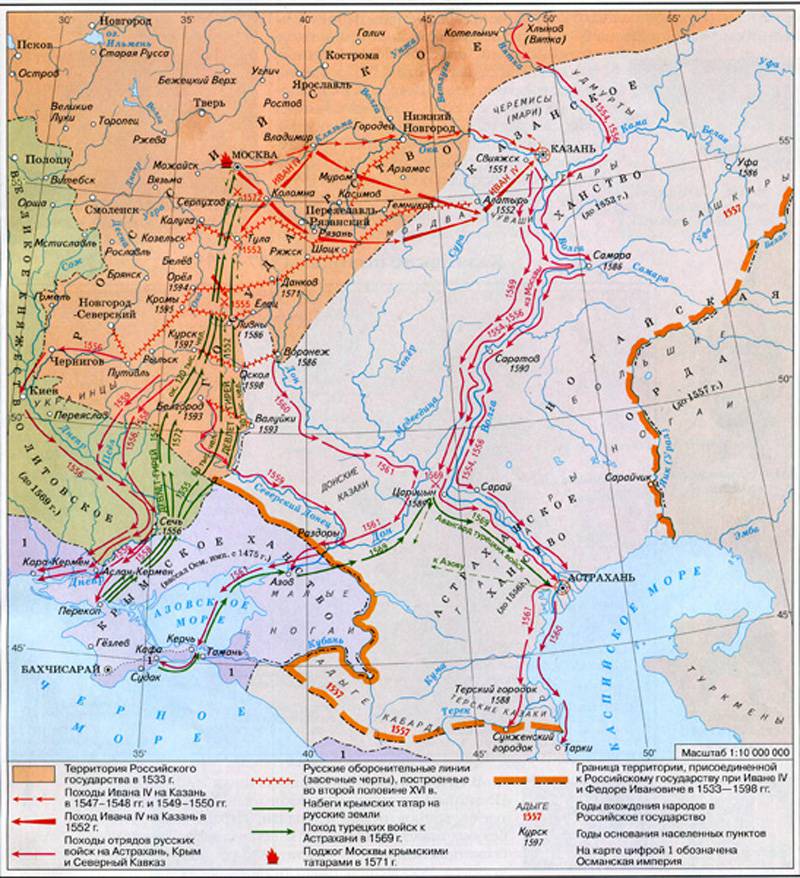
7 September 1566 of the year in its luxurious camping tent near the walls of the Hungarian fortress Szigetvar at four o'clock in the morning ended Sultan Suleiman the Magnificent. Neither the enemies nor the subjects did not question his merits or titles. With his life, and the whole era in stories Ottoman Empire, the era of its unstoppable expansion, many victories and rare defeats. The brilliant Port was still strong and powerful, but from now on its star will slowly but uncontrollably tarnish, and the sharp scimitar will lose its sharpness and swiftness. The next day, the Sigetvar fortress was taken, and the territories south of the island of Balaton became Turkish. But it was only the beginning of the descent from a high mountain, at the foot of which, in three and a half centuries, Mustafa Kemal will wait in the wings.
Thanks to the efforts of the Grand Vizier Mehmed Pasha Sokol in the army, the death of the ruler was concealed for some time in order to avoid any incidents connected with the succession to the throne. So the son of Sultan and his beloved wife, Alexandra Anastasia Lisowska Selim, was able to easily reach the capital from his residence and take the right to the throne. The rule of the new ruler of Istanbul began with the next rebellion of the Janissaries, who demanded payment of arrears in salary. At the insistence of the wise vizier, Selim was forced to make concessions: scrape the bottom of the barrel and pay what is owed to the disgruntled. With such an action began the reign of Selim II, nicknamed his subjects Krasnonym for excessive use of alcohol-containing potions. It was with this that the Sultan of the Ottoman Empire first encountered in the military arena with a new adversary. Far in the north, the Russian kingdom grew stronger and overgrown with new lands, which foreigners called (not without malicious intent) Muscovy, where Ivan IV ruled with his powerful hand.
Astrakhan becomes Russian
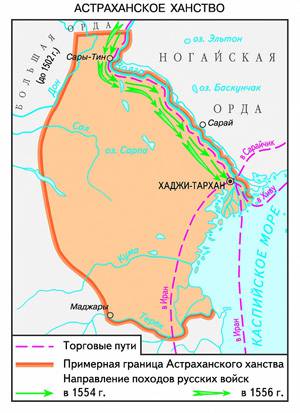
After the fall of the Kazan Khanate in 1552, the turn of its southern neighbor, the Astrakhan Khanate, came. In October, a delegation from the Nogais arrived in Moscow on 1553 with a request to take measures against the Astrakhan Khan Yamgurchi, who was constantly rattling their neighbors, who in turn promised to "fulfill the will of the sovereign." Possession of Astrakhan would give the tsar control over the entire Volga and, accordingly, over all the water trading arteries. In the spring of 1554, the Russian army under the command of Prince Yury Ivanovich Pronsky-Shemyakin in the number of 30 thousand people moved along the Volga to Astrakhan. A little later, this army was reinforced by a contingent of Vyatka service people led by Prince Alexander Vyazemsky. The first clash with the Astrakhan Tatars occurred in the Black Island area on the site of modern Volgograd. Tatars were defeated, they took prisoners, who informed the Russians that Khan Yamgurchi himself, with the main forces, was encamped below Astrakhan.
After making adjustments to the campaign plans, Pronsky-Shemyakin further moved directly to Astrakhan by water, and Prince Vyazemsky received an order to attack the Yamgurchi army. The city went to the Russian army without resistance - the Tatars defending it considered the best to flee. Khan also did not want to meet with his opponent, especially in his army began desertion. With a small detachment of warriors loyal to him, he went to Azov. Numerous wives and children, along with some valuable property, Yamgurchi sent by waterway down to the Caspian Sea. The Russians, however, managed to intercept the Khan's convoy and capture it.
However, Moscow had its own plans in the affairs of the succession to the throne, in which, of course, neither the khan nor his family had anything to do. Together with the Russian army, a new khan, Dervish Ali, arrived in Astrakhan. Earlier, Dervish Ali was here in power, however, having suffered a defeat in another civil strife, he was forced to flee to Russia, where he lived for some time in Zvenigorod with the full patronage of the royal authorities. The local population swore to the new ruler, a royal decree was published: on pain of death, to release all Russians who are in slavery. Dervish-Ali pledged to pay an annual tribute in the amount of 40 thousand altyn and a significant amount of valuable fish. Tsar fishermen were entitled to free fishing from Kazan to Astrakhan, however, the Tatars were also allowed to catch. In order to exclude further nuances in the struggle for power and the succession to the throne, in the event of the death of Dervish-Ali, the local people should have sent the appropriate petition to the king. In such a situation, the king himself appointed a new ruler at his discretion. All prisoners from among the warriors of the fugitive Yamgurchi were released, taking with him only his wives and children.
While all these events took place, the civil strife that was usual for them took place in the neighboring Nogai Hordes. The initiator of sending ambassadors to Ivan IV Murza Ismail fought with his brother Yusuf and other relatives. Despite his difficult situation, Ishmael found time to write petitions to Moscow with urgent requests to introduce direct royal rule in Astrakhan and remove Dervish Ali, who was rapidly losing popularity, from there. Thanks to Khan, who had recently been a political émigré, evaporated like smoke of incense, and very soon he began to feel an irresistible desire to be completely independent of Moscow. Petitions and denunciations on Dervish Ali rained on the capital incessantly, sowing doubts and suspicions until finally they were confirmed. In the spring of 1556, a detachment of Crimean Tatars approached Astrakhan, and the Khan, who instantly lost all friendliness, drove a small Russian garrison out of the city, consisting of 500 people. Ivan IV urgently sent a military detachment to help along the Volga, which was soon joined by Don Cossacks who arrived in time. The combined forces of the Russians approached Astrakhan, but Dervish Ali, like his predecessor, quickly lost all of his determination and also escaped to Turkish Azov by evil irony. Russian troops re-entered Astrakhan without encountering resistance. Meanwhile, tired of the internecine struggle, the Nogais finally reached an agreement and officially announced the acceptance of Russian citizenship. Thus, the mouth of the Volga finally passed under the control of the Russian state.
Combinations of the Crimean Khan
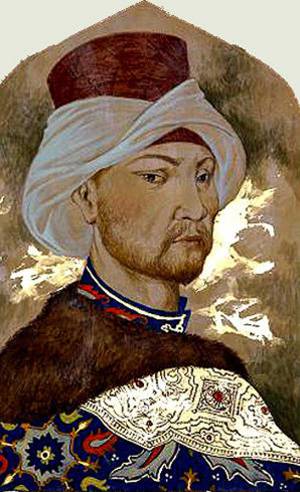
Initially, news of the accession of the Kazan and Astrakhan khanates did not cause a special reaction in Istanbul. In the Ottoman Empire waited for a solution to more serious problems. First, a mutiny of an impostor, posing as the executed son of Suleiman Mustafa. Then in 1559, the other sultan heirs Selim and Bayazid found out the relationship between themselves by force weapons. Only in 1563, the gaze of an aging sultan turned north. In October of this year, the envoy was sent to the Crimean Khan, Devlet Giray, with instructions to prepare for the next year to march on Astrakhan. This decision of Suleiman caused very serious concerns in the Crimea. The fact is that Devlet Giray considered himself a full-fledged and very significant political player in the Northern Black Sea region and tried to reduce his dependence on Istanbul to a minimum. Unfortunately, the Khan had to reckon with the Turks, since their fortresses with the garrisons located in the Crimea were located there. In addition, for help, they could also be contacted if neighbors were buffeted. The seizure of Astrakhan promised to strengthen the Turkish military presence in the Don and Volga region and, consequently, increased the dependence of the Crimea.
At the court of Devlet Girei, serious passions were in full swing: several groups, sponsored from various sources, fought for political influence among themselves. There were murza, which expressed Polish-Lithuanian interests, and the Russian state tried to form its own party. Traditionally, those who were the promoters of the interests of the Ottoman Empire were influential. Devlet Giray had to concentrate and skillfully maneuver in order, on the one hand, not to quarrel with powerful Suleiman, and on the other, to preserve his independence.
The arrival of the ombudsman did not go unnoticed at the Russian Embassy in the Crimea, headed by Athanasius Nagy. In order to clarify the situation and collect the necessary intelligence information, the Turkish official was invited to a "friendly dinner", where, in an appropriate situation, Naguym was succeeded in taking in the envoy, who had softened from the pickles. It turned out that the impetus for the decision to march on Astrakhan were three factors. Firstly, the grand vizier Sokollu Mehmed Pasha was carrying out a plan for making a canal between the Don and the Volga. The access to the Caspian would significantly strengthen the position of the Turks in their long struggle with the Persian Shah. Secondly, Suleiman received several letters from the Circassian nobility asking for protection, since the Russian Cossacks erected several of their strongholds on the Terek and Sunzha rivers and constantly assisted the Kabardian princes, who were vassals of the Russian state. Thirdly, the capture of Astrakhan violated the traditional routes to the north of the Caspian Sea, for pilgrims who followed the Muslim shrines from Central Asia.
The combination of all of the above, together with the energy of Sokollu Mehmed Pasha, and contributed to the decision to march on Astrakhan. Unexpected though indirect help in preventing the march on Astrakhan to the Russian ambassadors was rendered by the Khan himself. Just Devlet Giray held a completely different opinion regarding the upcoming enterprise. At first he tried to redirect the course of the forthcoming expedition from the peripheral Astrakhan to the Russian kingdom itself. The calculation was simple: with the help of a powerful Turkish army to take a rich booty, and after she returned to the places of permanent deployment, stay, as they say, with her. Without waiting for the results, an energetic Khan began to exaggerate, exposing the situation in black. Devlet Giray picturesquely reported to Istanbul all the difficulties of the march across the steppe - waterless and unsuitable for the Turks. Say, in the summer there is absolutely no water, and in the winter there are terrible frosts. The colorful composition of the inevitable death of the Ottoman army in the Caspian steppes was expertly supplemented by supposedly reliable rumors that the Russian Tsar sent an 60-thousandth army to Astrakhan.
At the same time, an enterprising Crimean ruler, having shown a remarkable multi-vector approach, tried to collect possible dividends from his northern neighbor. Through his ambassadors in Moscow, he brought to Ivan the Terrible all the information about the upcoming campaign, proposing to settle interstate problems by handing over to the Tatars of Kazan and Astrakhan, arguing that they would be taken away by the Turks anyway, and this could be settled in peace. In parallel, Devlet Giray conducted a probe to receive a one-time tribute from the king. It is not known whether Ivan Vasilyevich got angry from such political initiatives, but the khan did not receive either cities or money. “When is it being done so that, having taken the cities, to give them away again?” - rhetorically the question was in Moscow.
Nevertheless, the black PR campaign undertaken by Khan to disrupt the campaign against Astrakhan bore fruit. The empire had enough of its concerns both inside and in Europe. Relations with the Habsburgs were ruined, restlessness on the borders with Persia was restless, and Suleiman was not at all fascinated by the expensive military expedition to the distant and unfamiliar land for the Turks.
The last who, under the rule of Suleiman the Magnificent, tried to persuade him to this enterprise, was the governor of Kafa, a Circassian by origin, Qasim Pasha. The Sultan treasury was rapidly depleted by ever-increasing military spending, and Kasim Pasha rested on the economic importance of seizing Astrakhan. In his opinion, the city could easily be turned into a large shopping center throughout Southeast Europe and Central Asia. However, the Sultan, preparing for his last military campaign in Hungary, turned out to be completely deaf to the arguments of the provincial governor. And then he was gone.
Father's shadow
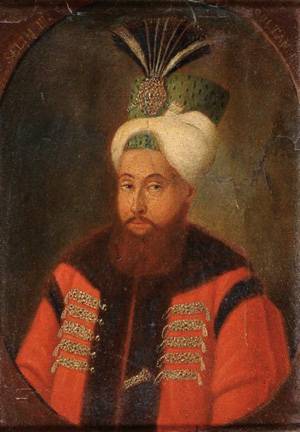
The first years of the reign of Selim II were marked by the establishment of order on the far reaches of a vast empire. In 1567, when the news of the death of Suleiman I reached the province of Yemen, the powerful imam Muttahar raised a rebellion against the Turks. It turned out that the common religion alone is not enough to bring the nomadic tribes living in these lands to obedience. The suppression of the insurgency was accompanied by technical and logistical difficulties due to the distance of Yemen from the central regions of the Ottoman Empire. In this regard, the question of building a channel between the Mediterranean and the Red Seas was put on the agenda. But beyond the proposals this project has not progressed.
The Grand Vizier Sokollu Mehmed Pasha, who still remains under power, did not abandon his plan to create another channel - between the Volga and the Don, which under favorable circumstances reminded the young sultan. After consulting with the relevant experts, it was decided that this was entirely possible. Selim II, remembering the unpleasant moments of the beginning of his reign, craved for military glory, so getting his permission and approval for the Astrakhan campaign was not difficult. The role played not only by the ambitions of the young Sultan and the great interest in the issues of engineering construction and supply of the troops of the Grand Vizier. The most important factor was the foreign policy factor. The Circassian diaspora, traditionally strong at court, made it clear that the expulsion of Russians from Astrakhan was highly desirable, relying on which they strengthened their positions in the North Caucasus. The Crimean Khan, who was very sensitive to the successes of Russia in the Livonian War, was seriously afraid to find himself in the semi-circle of his enemies and was not so hostile to the idea of a campaign. Finally, the ever-growing complaints of influential merchants about the loss of a profitable trade route through the Volga reached their highest ears, and the empire needed even more money than new territories.
Prepare
By Devlet Giray in the Crimea were sent again the highest instructions to prepare for the march on Astrakhan. 3 April 1568 agents of the Moscow ambassadors in the Crimea reported on the great military council held by the Khan, at which a letter was sent from Istanbul. Thus, the Russian became known plans for the implementation of unfulfilled plans five years ago. Soon, the enthusiasm of Devlet Giray again began to fall - Khan was informed that in the wagon train of the army preparing for the march the prince Crimea-Giray should arrive, who after the occupation of Astrakhan would lead the restored Astrakhan khanate. Sophisticated in intrigues, the ruler of the Crimea, not without reason, began to fear for the safety of his state powers, since palace coups in Bakhchisarai were a matter of ordinary and regular.
Devlet Giray believed that he was specially lured into a campaign, so that someone else would sit on the freed throne, and he himself would turn into another fugitive political emigrant-prizhivaly at the sultan's court. It is curious that quite recently, in his letters, he proved to the new sultan the acute need not only for “liberation of Astrakhan from the infidels,” but also for making the channel between the Volga and the Don. Khan obviously hoped that he would be helped with money and weapons (with cannons and calculations to them), would be welcome to hike, he would triumphantly expel the Russians from the city, and the Turks themselves would prophesy.
Seeing that Selim II is equipping a serious expedition, Devlet Giray began to get nervous. The preparation was really massive. In the shipyards, Kafa began the construction of ships capable of climbing up the Don. Necessary reserves and materials were delivered and stored in Azov. Troops were trained in Rumelia and the northern part of Asia Minor. The Russian embassy closely followed the preparations of the enemy for the campaign, collecting information through their agents. The build-up of forces took place gradually - it was necessary to concentrate a large number of various stocks, primarily provisions and gunpowder. The main warehouses of the Turkish army were to be located in the Crimea. In addition, an array of trenches and carts for groups of excavators, which were to work on the construction of the canal, were piling up in abundance.
On June 1, 1569, the Russian embassy became aware that a large number of troops and support personnel had already arrived in Kafu to serve rowing flotilla. The general command of the troops was carried out by the Kaf governor Kasim Pasha, who on May 31, the day when the agents returned and informed Ambassador Nagoy of the details, advanced with the vanguard on a land trip. Turkish artillery was transported on specially constructed flat-bottomed ships by the Azov-Don-Perevolok route. Some details of the Turkish plan became known: to approach Astrakhan, to besiege the city, and in case of failure to build a fortified fort in the old Tatar settlement, become a camp there and be ready for wintering. It was a set of measures in case of an adverse combination of circumstances, in general, the Turks were very confident in success.
In early June, it also became clear that in order to reinforce Kashima Pasha, another contingent of land forces was coming, which, having crossed the Dnieper, was supposed to take the direct route to Azov. The Russian ambassadors tried to continue to carry out intelligence activities, for which there were quite favorable conditions in the Crimea, thanks to the large number of Russian slaves and freedmen who were here, but circumstances intervened in this process. On June 10, the Khan Commissioner arrived to the Russian ambassadors with the appropriate prescription: Nagoya and his colleagues were divided with their people, allowing only translators to be kept with them. In fact, the ambassadors were interned and sent to the city of Mangup, which could mean only one thing - the beginning of the war.
Janissaries near Astrakhan
Devlet Giray did not refuse to sabotage the campaign in the winter of 1568 – 1569. conducted a diplomatic probe through trusted people on the subject of the transfer of Kazan and Astrakhan. And again he was firmly refused. Kasim Pasha was generally enthusiastic to launch an operation in 1568 with the forces that already existed. But the cunning and stubborn Khan protested, stating that he would not go anywhere without a Janissary, and if Kasim Pasha wished so, he could go forward on his own. Turkish troops at that time was still not enough, and it was decided to move the campaign to the next, 1569 year. However, when the Janissaries and artillery arrived in the Crimea in the spring, and the other part of the army forced the Dnieper, it was already impossible for Denlet Giray to unlock it. In addition to 17 – 18 thousand Turks and a significant number of digging workers, more than 50 thousand Tatars took part in the expedition against Astrakhan.
To spin the wheel, requires lubrication. For the Tatar cart lubrication required fat. In Istanbul, this was well understood and therefore the entire spring of 1569, Mr. Devlet Giray, received gifts of considerable volume and price. Khan's generous sultan's hand was poured 30 thousand gold "salary", 1000 caftans, 1000 pairs of boots, a lot of cuts of velvet and other expensive fabrics for decoration. However, Khan was tempted not only in combinations of political, but also in quartermaster. Referring to poverty and general scarcity, Devlet Girey begged 3 for thousands of pairs of boots, 3 for thousands of kaftans and a thousand Tegilyas from Turkish warehouses and some provisions from Kashim Pasha. Despite the fact that he received a large amount of equipment, Darlet Girey sought any opportunity to evade participation in the siege of Astrakhan. He wrote to Istanbul that the Tatars supposedly badly besieged the cities, therefore he asked for permission to “stand guard” at the ferries on the Volga, while the Turks would storm the Russian city. However, the answer from the Sultan's Palace, devoid of twofold interpretation, was that the Tatars were to take part in the campaign along with their Turkish allies.
From the very beginning, the hike was very difficult - the summer of 1569 was hot, Don was shallow, and even specially built transport ships climbed it with great difficulty. Those who traveled by land suffered from heat and thirst. At the very beginning of the campaign, both the Turks and the Tatars hurried deputations of all kinds of small steppe princes with an expression of ardent desire to participate in the enterprise, but only when the army of Kashima Pasha approaches Astrakhan. The most difficult thing was for the Nogais - some of the influential Murz did not mind accepting the citizenship of Selim II, but no one wanted to have affairs with the cunning Devlet Giray.
In the first half of August, Kasim Pasha finally reached Perevoloki. Turkish engineers carried out the first calculations, and it turned out that what is attractive on the map is not always the same as delightful at a direct acquaintance. In the area designated for the construction of the canal, the Volga and the Don were indeed no more than 65 kilometers apart. However, the area itself was very inaccessible for manual excavation - it was abundant in hills. After digging a little in the ground, the Turks decided to use a simpler and more traditional way: dragging the river flotilla vessels and all the equipment. True, for this purpose it would be necessary to level the ground, which also required great efforts. After weighing all the pros and cons, Kasim Pasha decided to send all the heavy weapons along the Don back to Azov, after which the troops carrying out this maneuver were ordered to go overland to Astrakhan. The Turkish commander himself, with whom the tireless Devlet Girey was constantly arguing, was about to go out to the Volga and go along the coast to the city from the north. When the Turkish troops finally passed the area between the two rivers and reached the Volga, the Astrakhan Tatars, or rather the part of them that experienced some inconvenience due to the Russians, came to their aid, driving a large number of boats.
The Russians were well aware of the Turkish preparations and did not count the crows on the walls. The garrison of Astrakhan was significantly strengthened; guns and ammunition were delivered to the city. The personnel were provided with provisions in case of a long siege. Despite the help of the local Tatar "resistance", Kasim Pasha moved slowly to Astrakhan, suffering from the heat and diseases that had begun. The Turks arrived at the city in early September, finding the Russians in full readiness to fight back. The heavy artillery and its ammunition were stuck somewhere on the way from Azov, and without it, Kasim Pasha did not dare to storm the city and, according to a preliminary plan, began to camp in the old settlement. There it was planned to build a fortress and winterize it.
But here, Devlet Giray suddenly went on strike. Almost 50 thousandth Tatar horde did not have the appropriate resources for wintering in the cold steppe, especially in their military practice, it was decided to return to the warm Crimea in the fall. Khan began to insist that the Turks let him go to winter apartments. Tatar was a lot, Istanbul is far, and Kasim Pasha was forced to yield to the onslaught of Devlet Giray. The horde gathered their nomadic possessions and left. The Turks were left alone near Astrakhan. The weather began to deteriorate, and with it the mood of the troops. A sharp discontent flared up, bordering on disobedience. The janissaries were outraged most loudly, bluntly stating that they were all threatened with death from starvation, since the huge army warehouses remained in the Crimea, and the stocks brought with them were rapidly melting.
Having learned about the unrest in the enemy camp, the Russians decided to further stir up the situation by resorting to the elementary method of information warfare. Through the captured Turks, the information was “merged” that down the Volga to the aid of Astrakhan was Prince Peter Serebryany along with the 30-thousandth army. And after the whole hundred-thousandth army of Ivan Belsky is preparing. The arrival of the Nogais was also expected, and even the alleged Shah of Persia, who perceived the campaign against Astrakhan as a threat against Persia, sent a contingent to the city by sea. It was something to fall into sad thoughts. And without that, the shattered nerves of Kashima Pasha finally surrendered - on September 20 1569, the Turks set fire to their wooden fortress and moved back. The road back was even more difficult - many Turks died because of lack of water and supplies. A crowd of exhausted ragged people, suffering from hunger and disease, returned to Azov. The first aggressive campaign of Selim II ended unsuccessfully, giving rise to doubts that the new sultan would be happy in the military field.
After the hike
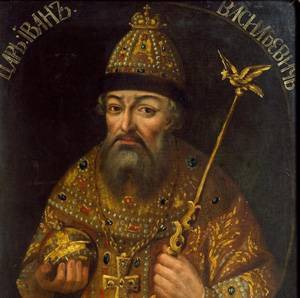
The next year, 1570, Tsar Ivan the Terrible sent envoy envoy deacon Novosil'tsev to Istanbul under a plausible excuse to congratulate the sultan on his accession to the throne and at the same time try to ward off the Ottomans from such wasteful and distant military expeditions. In Istanbul, the clerk met with the right people, handed over to whom should be encouraging gifts, in particular the favorite of Selim II Mehmet Pasha. Russian diplomacy failed to gain recognition from the Turks of Astrakhan’s accession and to conclude a peace treaty, but Selim did not send any Turkish troops against Astrakhan and against Russia. Driving through the Crimea, Novosiltsev learned that all military supplies and materials destined for the Astrakhan campaign were taken out of there by order of the Sultan.
It is curious that, while in Istanbul, Novosiltsev listened to many bitter complaints by Turkish officials against his ally and vassal, Devlet Giray. The Tatar Khan himself, getting rid of the Turkish presence, grew bolder and, having received another refusal to transfer Kazan and Astrakhan to him, with the 100-thousandth army invaded Russia. In May 1571, the horde reached Moscow, ravaging and burning its surroundings and suburbs. The city itself burned out badly - only the Kremlin remained whole, which Devlet Girey did not dare to storm. Taking a huge booty, the Tatars went to the Crimea. The next year, Khan tried to repeat his successful march, but was defeated in the bloody battle of the Young. No one else dared to ask or demand from Russia either Kazan or Astrakhan, which have become Russian cities since those distant times.
Turkish Sultan Selim II was indeed a military loser. In 1571, his fleet was devastatingly crushed by the combined forces of the Holy League under Lepanto. Astrakhan campaign 1569 of the year was the first of a whole series of Russian-Turkish conflicts, which are one of the longest military confrontations in world history.
Information